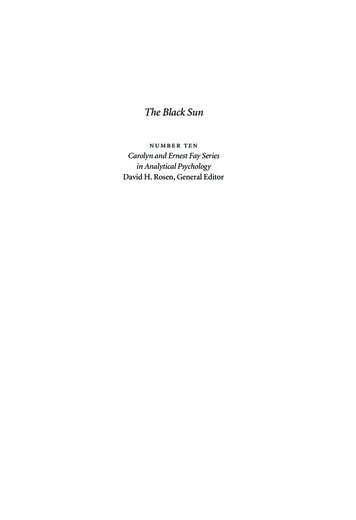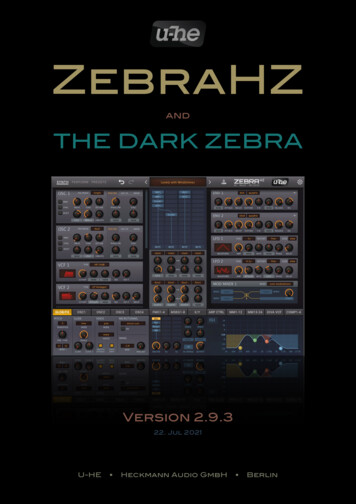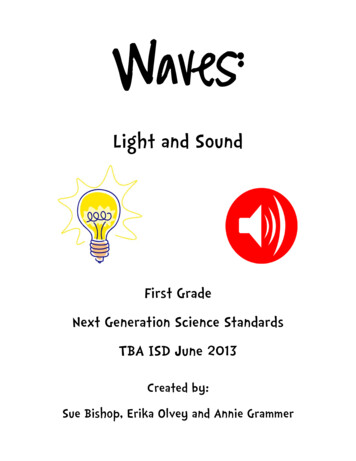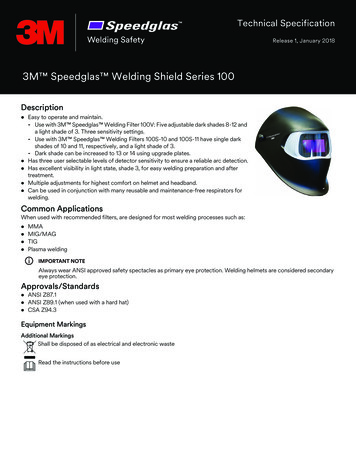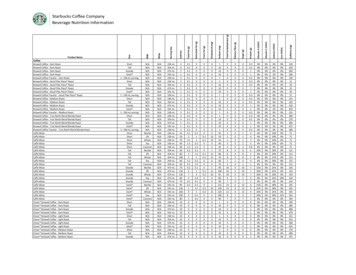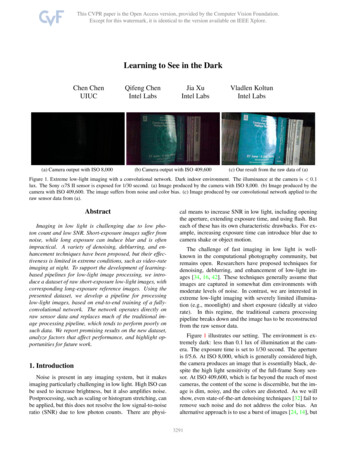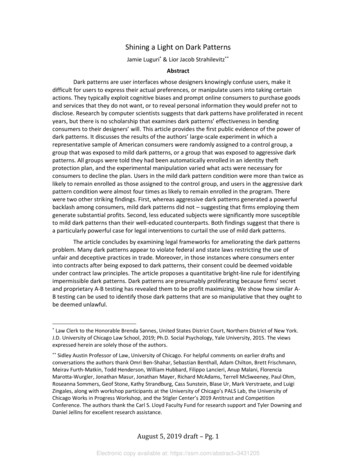
Transcription
Shining a Light on Dark PatternsJamie Luguri* & Lior Jacob Strahilevitz**AbstractDark patterns are user interfaces whose designers knowingly confuse users, make itdifficult for users to express their actual preferences, or manipulate users into taking certainactions. They typically exploit cognitive biases and prompt online consumers to purchase goodsand services that they do not want, or to reveal personal information they would prefer not todisclose. Research by computer scientists suggests that dark patterns have proliferated in recentyears, but there is no scholarship that examines dark patterns’ effectiveness in bendingconsumers to their designers’ will. This article provides the first public evidence of the power ofdark patterns. It discusses the results of the authors’ large-scale experiment in which arepresentative sample of American consumers were randomly assigned to a control group, agroup that was exposed to mild dark patterns, or a group that was exposed to aggressive darkpatterns. All groups were told they had been automatically enrolled in an identity theftprotection plan, and the experimental manipulation varied what acts were necessary forconsumers to decline the plan. Users in the mild dark pattern condition were more than twice aslikely to remain enrolled as those assigned to the control group, and users in the aggressive darkpattern condition were almost four times as likely to remain enrolled in the program. Therewere two other striking findings. First, whereas aggressive dark patterns generated a powerfulbacklash among consumers, mild dark patterns did not – suggesting that firms employing themgenerate substantial profits. Second, less educated subjects were significantly more susceptibleto mild dark patterns than their well-educated counterparts. Both findings suggest that there isa particularly powerful case for legal interventions to curtail the use of mild dark patterns.The article concludes by examining legal frameworks for ameliorating the dark patternsproblem. Many dark patterns appear to violate federal and state laws restricting the use ofunfair and deceptive practices in trade. Moreover, in those instances where consumers enterinto contracts after being exposed to dark patterns, their consent could be deemed voidableunder contract law principles. The article proposes a quantitative bright-line rule for identifyingimpermissible dark patterns. Dark patterns are presumably proliferating because firms’ secretand proprietary A-B testing has revealed them to be profit maximizing. We show how similar AB testing can be used to identify those dark patterns that are so manipulative that they ought tobe deemed unlawful.Law Clerk to the Honorable Brenda Sannes, United States District Court, Northern District of New York.J.D. University of Chicago Law School, 2019; Ph.D. Social Psychology, Yale University, 2015. The viewsexpressed herein are solely those of the authors.*Sidley Austin Professor of Law, University of Chicago. For helpful comments on earlier drafts andconversations the authors thank Omri Ben-Shahar, Sebastian Benthall, Adam Chilton, Brett Frischmann,Meirav Furth-Matkin, Todd Henderson, William Hubbard, Filippo Lancieri, Anup Malani, FlorenciaMarotta-Wurgler, Jonathan Masur, Jonathan Mayer, Richard McAdams, Terrell McSweeney, Paul Ohm,Roseanna Sommers, Geof Stone, Kathy Strandburg, Cass Sunstein, Blase Ur, Mark Verstraete, and LuigiZingales, along with workshop participants at the University of Chicago’s PALS Lab, the University ofChicago Works in Progress Workshop, and the Stigler Center’s 2019 Antitrust and CompetitionConference. The authors thank the Carl S. Lloyd Faculty Fund for research support and Tyler Downing andDaniel Jellins for excellent research assistance.**August 5, 2019 draft – Pg. 1Electronic copy available at: https://ssrn.com/abstract 3431205
Table of ContentsIntroduction . 3I.Dark Patterns in the Wild . 6II. An Experimental Test of the Effectiveness of Dark Patterns . 17A. Rates of Acceptance . 21B. The Influence of Stakes . 23C. Potential Repercussions of Deploying Dark Patterns . 24D. Predicting Dark Pattern Susceptibility . 27III.Are Dark Patterns Unlawful? . 29A. Laws Governing Deceptive and Unfair Practices in Trade . 30B. Other Relevant Federal Frameworks . 37C. Contracts and Consent . 38D. Line Drawing . 43E. Persuasion . 46Conclusion . 48August 5, 2019 draft – Pg. 2Electronic copy available at: https://ssrn.com/abstract 3431205
IntroductionEverybody has seen them before and found them frustrating, but most consumers don’tknow what to call them. They are what computer scientists have (for the last decade) describedas dark patterns,1 and they are a proliferating species of sludge (to use a term preferred bybehavioral economists)2 or market manipulation (the moniker preferred by some legalscholars).3 Dark patterns are user interfaces whose designers knowingly confuse users, make itdifficult for users to express their actual preferences, or manipulate users into taking certainactions. They typically prompt users to rely on System 1 decision-making rather than moredeliberate System 2 processes, exploiting cognitive biases like framing effects, the sunk costfallacy, and anchoring. The goal of most dark patterns is to manipulate the consumer into doingsomething that is inconsistent with her preferences, in contrast to marketing efforts that aredesigned to alter those preferences. The first wave of academic research into dark patternsidentified the phenomenon and developed a typology of dark pattern techniques.4This summer, computer scientists at Princeton and the University of Chicago took asecond step towards tackling the problem by releasing the first major academic study of theprevalence of dark patterns. 5 Arunesh Mathur and six co-authors developed a semi-automatedmethod for crawling more than 11,000 popular shopping websites. Their analysis revealed thepresence of dark patterns on more than 11% of those sites, and the most popular sites werealso most likely to employ dark patterns. 6If the first wave of scholarship created a useful taxonomy and the second step in thescholarship established the growing prevalence of dark pattern techniques then it seems clearwhere the literature ought to go next. Scholars need to quantify the effectiveness of darkpatterns in convincing online consumers to do things that they would otherwise prefer not toUser interface designer Harry Brignull coined the phrase in 2009 and maintains a web site thatdocuments them in an effort to shame the programmers behind them. Seehttps://www.darkpatterns.org/1Cass R. Sunstein, Sludges and Ordeals, 69 DUKE L.J. (forthcoming 2019); Richard H. Thaler, Nudge,Not Sludge, 361 Science 431 (2018). A sludge is an evil “nudge,” one that exploits their cognitive biases topersuade them to do something that is undesirable, typically by introducing excessive friction into choicearchitecture. See Cass R. Sunstein, Sludge Audits, Harvard Public Law Working Paper No. 19-21 (July 2,2019 draft), available at https://papers.ssrn.com/sol3/papers.cfm?abstract id 3379367 (hereinafterSunstein, Sludge Audits).2Ryan Calo, Digital Market Manipulation, 82 GEO. WASH. L. Rev. 995 (2014); Jon D. Hanson & Douglas A.Kysar, Taking Behavioralism Seriously: The Problem of Market Manipulation, 74 NYU L. REV. 632 (1999).3See, e.g., Christoph Bösch et al., Tales from the Dark Side: Privacy Dark Strategies and Privacy DarkPatterns, Proceedings on Privacy Enhancing Technologies (2016); Colin M Gray et al., The Dark (Patterns)Side of UX Design, PROCEEDINGS OF THE 2018 CHI CONFERENCE ON HUMAN FACTORS IN COMPUTING SYSTEMS (2018).4Arunesh Mathur at al., Dark Patterns at Scale: Findings from a Crawl of 11K Shopping Websites, July 17,2019 working paper, available at erns/assets/darkpatterns-v2.pdf.5As the authors themselves note, see id. at 2, this figure probably understates the prevalence of darkpatterns, because their taxonomy of dark patterns leaves out several important dark pattern mechanisms,perhaps in part because they are hard to identify using the semi-automated approach employed by theauthors. See infra table 1 (providing a taxonomy that omits nagging, bait and switch, aestheticmanipulation and other important types of dark patterns).6August 5, 2019 draft – Pg. 3Electronic copy available at: https://ssrn.com/abstract 3431205
do. In short, the question we pose in this paper is “how effective are dark patterns?” That is nota question that has been answered in academic research to date. But it is a vital inquiry if we areto understand the magnitude of the problem and whether regulation is appropriate.To be sure, the lack of published research does not mean that the effectiveness of thesetechniques is a complete mystery. On the contrary, we suspect that the kind of research resultswe report here have been replicated by social scientists working in-house for technology andecommerce companies. Our hunch is that consumers are seeing so many dark patterns in thewild because the internal, proprietary research suggests dark patterns are presently profitmaximizing for the firms that employ them. But those social scientists have had strongincentives to suppress the results of their A-B testing of dark patterns, so as to preserve dataabout the successes and failures of the techniques as trade secrets and (perhaps) to stem theemergence of public outrage and legislative or regulatory responses.With bipartisan legislation that would constrain the use of dark patterns currentlypending in the Senate,7 investigative reporters beginning to examine the dark patternsproblem,8 and one of the nation’s leading privacy scholars testifying before the Federal TradeCommission (F.T.C.) that in his estimation, 2019 would be the year of the dark pattern,9 ecommerce firms probably expect that, where the effectiveness of dark patterns is concerned,heat will follow light. So they have elected to keep the world in the dark for as long as possible.The strategy has worked so far.The basic problem of manipulation in marketing and sales is not unique to interactionsbetween computers and machines. The main factors that make this context interesting are itsrelative newness and scale. In both traditional and online contexts legal actors have to maketough decisions about where the precise line is between persuasion and manipulation, and whatconduct is misleading enough to eliminate what might otherwise be constitutionally protectedrights for sellers to engage in commercial speech. The law has long elected to prohibit certainstrategies for convincing people to part with money or personal information. Laws prohibitingfraud have been around, seemingly forever, and more recently implemented laws proscribepretexting. States and the federal government have given consumers special rights in settingscharacterized by high pressure, mild coercion, or vulnerability, such as door-to-door-sales, andtransactions involving funeral services, timeshares, telemarketing, or home equity loans.Sometimes the law enacts outright prohibitions with substantial penalties. Other times it createscooling off periods that cannot be waived. A key question we address is what online tactics areegregious enough to warrant this kind of special skepticism.Deceptive Experiences to Online Users Reduction Act (DETOUR Act), Senate Bill 1084, 116th Congress,introduced April 9, 2019, text available at ebill/1084/text.7See, e.g., Jennifer Valentino-Devries, How E-Commerce Sites Manipulate You into Buying Things You MayNot Want, N.Y. TIMES, June 24, 2019, at B1.8See F.T.C. Hearing, Competition and Consumer Protection in the Twenty-First Century, April 9, 2019,Testimony of Professor Paul Ohm, Georgetown University, Transcript at 49 (“my prediction for 2019 isthis is the year where dark patterns really becomes the kind of thing that we’re really talking a lotabout.”), available c events/1418273/FTC hearings session 12 transcript day 1 4-9-19.pdf.9August 5, 2019 draft – Pg. 4Electronic copy available at: https://ssrn.com/abstract 3431205
Ours is a descriptive paper, an empirical paper, a normative paper, and then adescriptive paper again. That said, the new experimental data we reveal is the most importanttake-away. Part I begins by describing dark patterns – what techniques they include and whatsome of the most prominent examples are. The description illuminates several real-world darkpatterns and suites of dark patterns employed by major multinational corporations. The Partalso provides a streamlined taxonomy of dark pattern techniques, one that builds on work thatcomputer scientists have done while providing some conceptual clarity that’s caused scholars ofhuman-computer interactions to lump together divergent phenomena.Part II provides the paper’s core contribution. As scholars have seen the proliferation ofdark patterns, many have assumed that dark patterns are efficacious. Why else would large,well-capitalized companies that are known to engage in A-B testing be rolling them out? Judgesconfronting dark patterns have for the most part shared these intuitions, though not universally.We show that many widely employed dark patterns prompt consumers to do what they wouldnot do in a more neutral decision-making environment. But beyond that, we provide the firstcomparative evidence that quantifies how well they work, and that sheds some light on thequestion of which techniques work best. Our bottom line is that dark patterns are strikinglyeffective in getting consumers to do what they would not do when confronted with more neutraluser interfaces. Relatively mild dark patterns more than doubled the percentage of consumerswho signed up for a dubious identity theft protection service that we told our subjects we wereselling, and aggressive dark pattern nearly quadrupled the percentage of consumers signing up.In social science terms, the magnitudes of these effects are enormous. We then providepowerful evidence that dosage matters – aggressive dark patterns generate a powerfulcustomer backlash. Mild dark patterns usually do not, and therefore, counterintuitively, thestrongest case for regulation and other legal intervention concerns subtle uses of dark patterns.Finally, we provide compelling evidence that less educated Americans are significantly morevulnerable to dark patterns than their more educated counterparts, and that trend isparticularly pronounced where subtler dark patterns are concerned. This observation raisesdistributive issues and is also useful as we consider how the law might respond to dark patterns.Part III looks at the existing law and asks whether it prohibits dark patterns. This is animportant area for inquiry because pending bipartisan legislation proposes that the F.T.C. begiven new authority to prohibit dark patterns. 10 It turns out that with respect to a number ofcentral dark pattern techniques, the F.T.C. is already going after some kinds of dark patterns,and the federal courts have been happy to cheer the agency along. The most successful actionshave nearly all fallen under the F.T.C.’s section five authority to regulate deceptive acts andpractices in trade. To be sure, other important dark patters fit less comfortably within thecategories of deceptive or misleading trade practices, and there is lingering uncertainty as tohow much the F.T.C.’s authority to restrict unfair trade practices will empower the agency torestrict that behavior. The passage of federal legislation aimed squarely at dark patterns wouldprovide useful new legal tools, but there is no reason to delay enforcement efforts directed ategregious dark patterns while waiting on Congress to do something.Of course, the F.T.C. lacks the resources to be everywhere, so a critical issue goingforward will be whether contracts that are agreed to in large measure because of a seller’s useof dark patterns are deemed valid. This issue is just now starting to bubble up in the case law. Todeal with this question, and other important line-drawing questions, we propose a quantitative10See supra text accompanying note 7.August 5, 2019 draft – Pg. 5Electronic copy available at: https://ssrn.com/abstract 3431205
“more likely than not” approach to regulation. The method we use in this paper is easy toreplicate, and the math is not especially fancy. Where the use of a dark pattern technique morethan doubles the rate of acceptance compared to neutral choice architecture, the law shouldregard the dark pattern’s use as per se unlawful. To be sure, that is an underinclusive test, onethat should be supplemented by a balancing inquiry. But we think it is a good andstraightforward place to start as the law begins to grapple seriously with the question of how toregulate dark patterns. Notably, both the mild and aggressive dark patterns we testedexperimentally satisfied that test. As we explain in Part III, there is a plausible case to be madethat agreements procured through the use of dark patterns are voidable as a matter of contractlaw under the undue influence doctrine.We said at the outset that dark patterns are different than other forms of dodgybusiness practices because of the scale of e-commerce. There may be poetic justice in thenotion that this very scale presents an opportunity for creative legal regulators. It is exceedinglydifficult to figure out whether a door to door salesperson’s least savory tactics significantlyaffected the chances of a purchase – was the verbal sleight of hand material or incidental? Whoknows? But with e-commerce, firms can run thousands of consumers through identicalinterfaces at a reasonable cost and see how small tweaks to the software might alter userbehavior. Social scientists working in academia or for the government can do this too; we justhaven’t done so before today. Now that scholars can test dark patterns, we can isolatecausation in a way that’s heretofore been impossible in the brick-and-mortar world. Unlikebrick-and-mortar manipulation, dark patterns are hiding in plain sight, operate on a massivescale, and are relatively easy to detect. Those facts strengthen the case further for the legalsystem to address their proliferation.So let’s spend some time getting to know dark patterns.I.Dark Patterns in the WildSuppose you are getting commercial emails from a company and wish to unsubscribe. Ifthe company is following the law they will include in their emails a link to a page that allows youto remove your email address.11 Some companies make that process simple, automaticallyremoving your address when you click on an unsubscribe link or taking you to a page that asksyou to type in your email address to unsubscribe. Once you do so they will stop sending youemails.Other companies will employ various tools to try to keep you on their lists. They mayremind you that if you unsubscribe you will lose out on valuable opportunities to save money ontheir latest products (dark patterns researchers call this practice “confirmshaming”). Or they’llgive you a number of options besides the full unsubscribe that most people presumably want,such as “receive emails from us once a week” or “receive fewer emails from us” while makingusers who want to receive no more emails click through to a subsequent page. 12 (These11This is required by the CAN-SPAM Act of 2003, 15 U.S.C. § 103.As of July 2019, Best Buy’s unsubscribe link in commercial emails followed this pattern. If a user clickedon the unsubscribe hyperlink at the bottom of a marketing email, she would be taken to a screen thatprovided three options: “Receive all General Marketing emails from Best Buy.” [This box is checked bydefault, so a user who clicks “unsubscribe” and then “submit” will not stop receiving emails from BestBuy.] The second option says, “Receive no more than one General Marketing email per week.” And thethird option is “Receive no General Marketing emails (unsubscribe).”12August 5, 2019 draft – Pg. 6Electronic copy available at: https://ssrn.com/abstract 3431205
techniques are referred to as “obstruction” dark patterns).13 The company is making it easy foryou to do what it prefers (you continue to receive lots of marketing emails), and harder for youto do the thing it can live with (receiving fewer emails), or the thing you probably prefer and areentitled to by law (receiving no emails from the company).In other instances, firms employ highly confusing “trick question” prompts that make ithard for even smart consumers to figure out how they are to accomplish their desired objective.For instance, see the membership cancellation page from the Pressed Juicery:14Other aggravating examples of dark patterns abound. If you have found it easy to signup for a service online, with just a click or two, but when it came time to cancel the service hadto make a phone call or send a letter via snail mail, you have been caught in a “roach motel”dark pattern (it’s easy to get in but hard to get out). If you’ve ever seen an item in your shoppingcart that you did not add to it and wondered how it got there, you have encountered a “sneakinto the cart” dark pattern. If you’ve once been given a choice between signing up fornotifications, with the only options presented being “Yes” and “Not Now,” only to be askedagain about signing up for notifications two weeks later when you select “Not Now,” that’s a“nagging” dark pattern. Here is one from Ticketmaster’s smartphone app. 15Gray et al., supra note 4, at 5-6; LIOR STRAHILEVITZ ET AL., SUBCOMMITTEE REPORT: PRIVACY AND DATA PROTECTION,STIGLER CENTER COMMITTEE FOR THE STUDY OF DIGITAL PLATFORMS 22-23 (2019).13For this example, we thank Karin Curkowicz. 150721331214Google Maps does essentially the same thing. When a user repeatedly travels to a particular locationand uses the apps’ directions, the app will display a “Go here often?” pop-up window that asks whetherthe location is her “Home,” “Work,” or “Other” (school, gym, etc.) approximately once a week. A user canclose the window each time but there is evidently no way to prevent the queries from reappearing shortof deleting all location history. The pop-up window notes that users’ labels for locations “will be usedacross Google products, for personalized recommendations, and for more useful ads.”15August 5, 2019 draft – Pg. 7Electronic copy available at: https://ssrn.com/abstract 3431205
Bait and switch is another time-tested dodgy business practice, and the tactic hasemerged online as a type of dark pattern. Sometimes it arises in its classic form, and sometimesit emerges as a bait-and-sell and switch, where the customer does get to purchase the good orservice that was advertised, but is then shown a barrage of ads for things the customer does notwant. Here is an example of the latter from one of the author’s recent online purchases fromthe aforementioned Ticketmaster.August 5, 2019 draft – Pg. 8Electronic copy available at: https://ssrn.com/abstract 3431205
Alexander Hamilton was generally depicted clean-shaven in portraits.16 Other than that, it’s notclear what the connection is between the ticket purchase and a razor-blade subscription. Noticefurther that besides bait and switch there are two subtler dark patterns embedded in the imageabove. In the ad, “Yes please” appears against a bright blue background while “No thanks”appears less legible against a gray one. Moreover, another even lighter gray font (barely legiblein the pop-up ad) reveals important text about what a consumer has to click on to skip theseveral bait-and-switch ads that would follow, which in this case included further offers fromHotels.com, Priceline, and Hulu. The font appears much less prominently than the darker textabove it about the razor blade offer.Another common dark pattern is generating false or misleading messages aboutdemand for products or testimonials. Arunesh Mathur and co-authors recently revealed that anumber of popular shopping sites display information about recent sales activities that is drivenby random number generators and similar techniques. For example, they caught thredup.comusing a random number generator to display information about how many of a particularproduct were “just sold” in the last hour, and they found various sports jersey sales sites usingidentically phrased customer testimonials but with different customer names each time.17 Whena site notes that Anna in Anchorage just purchased a jacket that a user is examining, theacademic research suggests these high-demand messages should be taken with a large grain ofsalt.Having introduced a few vivid examples of dark patterns, it seems appropriate tointroduce a workable taxonomy of the techniques. Several have been developed in the existingliterature. One problem is that as interest in dark patterns has grown, so has the ostensible listof what counts as one. Putting together the various taxonomies in the literature results in arather lengthy list, with some techniques being very problematic and others less so. There havebeen four key taxonomies to emerge in the dark patterns literature, with each building on andtweaking what came before. The chart below reproduces the current aggregated taxonomy inthe literature and identifies which types of dark patterns have been identified in multipletaxonomies versus only some. 18 Our literature review reveals eight categories of dark patternsand 27 variants.19 After presenting this information we will propose a modified, streamlinedtaxonomy that appropriately focuses on the means (the manipulative techniques used) ratherthan the ends (getting users to provide sensitive information, cash, recruit others, etc.). It isworth noting at the outset that some of the choices different teams of scholars have made inpresenting their taxonomies relate to their different objectives. For example, some scholars, likeBösch et al, are not trying to be comprehensive. Others, like Mathur et al., are focusing on thesorts of dark patterns that can be identified using a semi-automated web-crawling process. Suchprocesses lend themselves to flagging certain kinds of dark patterns (such as low-stockmessages) more readily than others (such as toying with emotions).16Alas, so was Aaron Burr.17Mathur et al., supra note 5, at 18-19.Most of the dark patterns literature is co-authored. For space-saving reasons, we include in the tableonly the surname of the first listed author of such work.18We apologize for the small font size necessary to squeeze the table onto a page. We promise the tableis not intended to be a dark pattern – we actually want you to read the categories and examples closely.19August 5, 2019 draft – Pg. 9Electronic copy available at: https://ssrn.com/abstract 3431205
Table 1: Summary of Existing Dark Pattern TaxonomiesCategoryVariantDescriptionSourceRepeated requests to dosomething firm prefersGrayActivity messagesFalse / misleading Notice thatothers are purchasing,contributingMathurTestimonialsFalse / misleading positivestatements from customersMathurRoach MotelAsymmetry between signing upand cancelingGray, MathurPrice Comparison PreventionFrustrates comparison shoppingBrignull, Gray, MathurIntermediate CurrencyPurchases in virtual currency toobscure costBrignullImmortal AccountsAccount and consumer infocannot be deletedBöschSneak into BasketItem consumer did not add is incartBrignull, Gray, MathurHidden CostsCosts obscured / disclosed late intransactionBrignull, Gray, MathurHidden subscription / forcedcontinuityUnanticipated / undesiredautomatic renewalBrignull, Gray, MathurBait & SwitchCustomer sold something otherthan what’s originally advertisedGrayHidden information / aestheticmanipulationImportant information visuallyobscuredGrayPreselectionFirm-friendly default ispreselectedBösch, GrayToying with emotionEmotionally manipulative framingGrayFalse hierarchy / pressured sellingManipulation to select moreexpensive versionGray, MathurTrick questionsIntentional or obvious ambiguityGray, MathurDisguised AdConsumer induced to click onsomething that isn’t apparent adBrignull, GrayConfirmshamingChoice framed in way that makesit seem dishonorable, stupidBrignull, MathurCutenessConsumers likely to trustattractive robotLaceyFriend spam / social pyramid /address book leechingManipulative extraction ofinformation about other usersBrignull, Bösch, GrayPrivacy ZuckeringConsumers tricked into sharingpersonal infoBrignull, Bösch, GrayGamificationFeatures earned throughrepeated useGrayForced RegistrationConsumer tricked into thinkingregistration necessaryBöschLow stock messageConsumer informed of limitedquantitiesMathurHigh demand messageConsumer informed
Shining a Light on Dark Patterns Jamie Luguri* & Lior Jacob Strahilevitz** Abstract Dark patterns are user interfaces whose designers knowingly confuse users, make it difficult for users to express their actual pref
